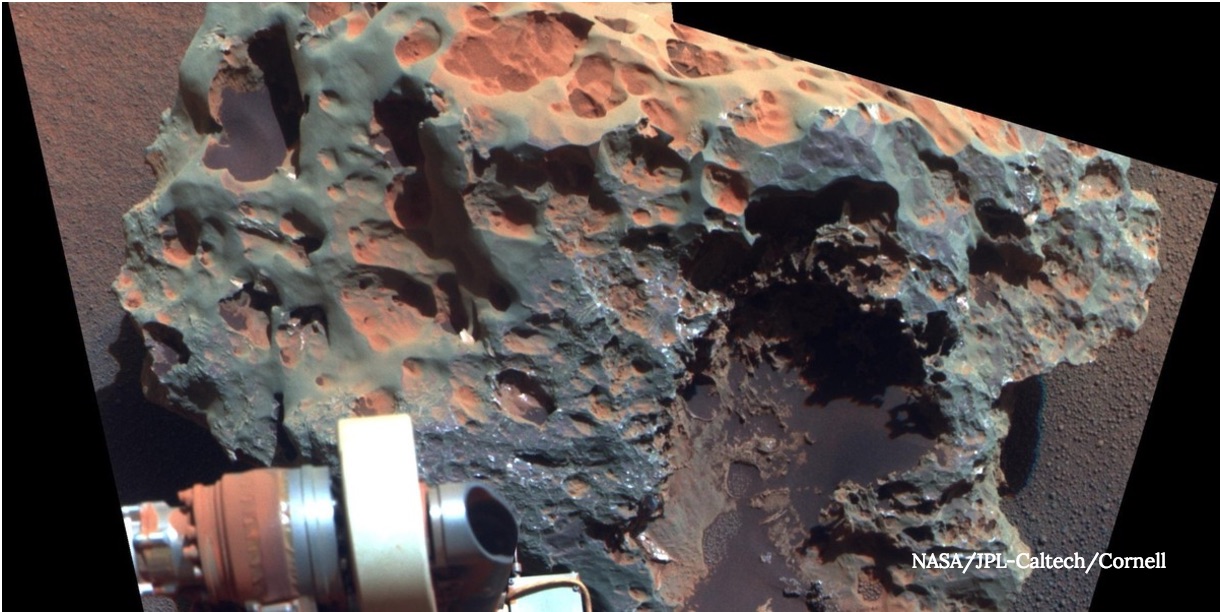Mars' Mega-Drought Revealed in Meteorite Rust

As the world looks toward Mars as the first destination for humanity's foray into the solar system, it's time for a reality check.
We already know the Red Planet is bathed in radiation, has a thin atmosphere and is, for the most part, inhospitable for life (as we know it), but astrobiologists think there might be just enough water below the surface to support microbial life and there was likely a lot more water on the surface in the Red Planet's past. The mere hint of water on Mars is enough for us to hope we can use it to sustain a future Mars settlement.
Now, in new research published in the journal Nature Communications, researchers report on the results of analysis of Mars meteors by NASA's Opportunity rover that has been exploring Mars for over 12 years.
Iron-rich meteorites weather very quickly when exposed to a wet environment. On Earth, these space rocks rust. And though meteorites also rust on Mars, Opportunity has found that they rust at a much, much slower rate and has revealed that the planet has been extremely dry for millions of years.
RELATED: Space Invader on Mars: Curiosity Finds a Meteorite
"Evidence shows that more than 3 billion years ago Mars was wet and habitable. However, this latest research reaffirms just how dry the environment is today," said Christian Schröder, of the University of Stirling and Science Team Collaborator for the Mars Exploration Rover Opportunity, in a statement. "For life to exist in the areas we investigated, it would need to find pockets far beneath the surface, located away from the dryness and radiation present on the ground."
Although recent discoveries by NASA's Curiosity rover suggest liquid water infused with toxic perchlorate salts might condense on the surface, the reality is that the Martian atmosphere is still extremely arid. "(T)his moisture is much less than the moisture present even in the driest places on Earth," added Schröder.
Get the Space.com Newsletter
Breaking space news, the latest updates on rocket launches, skywatching events and more!
RELATED: Mystery Rock 'Appears' in Front of Mars Rover
After studying a cluster of meteorites in the equatorial Meridiani Planum region of Mars, Opportunity found that their rust rate is 10-10,000 times less than how long it would take iron-rich meteorites to rust in the driest deserts on Earth. This suggests Mars has been incredibly dry for millions of years, only adding more mystery to how the Red Planet transitioned from a wet planet to a very dry one.
This is obviously pretty bad news for the hope of finding any basic forms of Martian life remotely near the surface, but it adds another layer of uncertainty for future Mars missions. For any Mars mission plan, tapping into Mars' meager water supply is essential to keep astronauts alive and, in some cases, provide fuel for a sustained presence. This most recent finding will no doubt force mission planners to carefully consider where a future human presence on Mars should touch down, and it probably won't be anywhere near the equator.
Originally published on Seeker.
Join our Space Forums to keep talking space on the latest missions, night sky and more! And if you have a news tip, correction or comment, let us know at: community@space.com.
Ian O'Neill is a media relations specialist at NASA's Jet Propulsion Laboratory (JPL) in Southern California. Prior to joining JPL, he served as editor for the Astronomical Society of the Pacific‘s Mercury magazine and Mercury Online and contributed articles to a number of other publications, including Space.com, Space.com, Live Science, HISTORY.com, Scientific American. Ian holds a Ph.D in solar physics and a master's degree in planetary and space physics.










